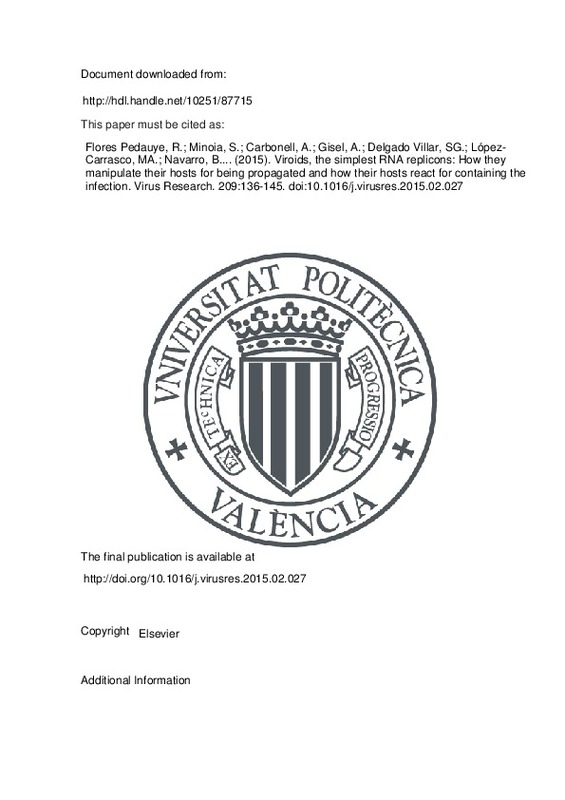Flores Pedauye, R.; Minoia, S.; Carbonell, A.; Gisel, A.; Delgado Villar, SG.; López-Carrasco, MA.; Navarro, B.... (2015). Viroids, the simplest RNA replicons: How they manipulate their hosts for being propagated and how their hosts react for containing the infection. Virus Research. 209:136-145. https://doi.org/10.1016/j.virusres.2015.02.027
Por favor, use este identificador para citar o enlazar este ítem: http://hdl.handle.net/10251/87715
|
Título:
|
Viroids, the simplest RNA replicons: How they manipulate their hosts for being propagated and how their hosts react for containing the infection
|
|
Autor:
|
 Flores Pedauye, Ricardo
Minoia, Sofia
Carbonell, Alberto
Gisel, A.
Delgado Villar, Sonia Guadalupe
López-Carrasco, María Amparo
Navarro, B
Di Serio, Francesco
Flores Pedauye, Ricardo
Minoia, Sofia
Carbonell, Alberto
Gisel, A.
Delgado Villar, Sonia Guadalupe
López-Carrasco, María Amparo
Navarro, B
Di Serio, Francesco
|
|
Entidad UPV:
|
Universitat Politècnica de València. Instituto Universitario Mixto de Biología Molecular y Celular de Plantas - Institut Universitari Mixt de Biologia Molecular i Cel·lular de Plantes
|
|
Fecha difusión:
|
|
|
Resumen:
|
[EN] The discovery of viroids about 45 years ago heralded a revolution in Biology: small RNAs comprising around 350 nt were found to be able to replicate autonomously and to incite diseases in certain plants without encoding ...[+]
[EN] The discovery of viroids about 45 years ago heralded a revolution in Biology: small RNAs comprising around 350 nt were found to be able to replicate autonomously and to incite diseases in certain plants without encoding proteins, fundamental properties discriminating these infectious agents from viruses. The initial focus on the pathological effects usually accompanying infection by viroids soon shifted to their molecular features they are circular molecules that fold upon themselves adopting compact secondary conformations and then to how they manipulate their hosts to be propagated. Replication of viroids in the nucleus or chloroplasts through a rolling-circle mechanism involving polymerization, cleavage and circularization of RNA strands dealt three surprises: (i) certain RNA polymerases are redirected to accept RNA instead of their DNA templates, (ii) cleavage in chloroplastic viroids is not mediated by host enzymes but by hammerhead ribozymes, and (iii) circularization in nuclear viroids is catalyzed by a DNA ligase redirected to act upon RNA substrates. These enzymes (and ribozymes) are most probably assisted by host proteins, including transcription factors and RNA chaperones. Movement of viroids, first intracellularly and then to adjacent cells and distal plant parts, has turned out to be a tightly regulated process in which specific RNA structural motifs play a crucial role. More recently, the advent of RNA silencing has brought new views on how viroids may cause disease and on how their hosts react to contain the infection; additionally, viroid infection may be restricted by other mechanisms. Representing the lowest step on the biological size scale, viroids have also attracted considerable interest to get a tentative picture of the essential characteristics of the primitive replicons that populated the postulated RNA world. (C) 2015 Elsevier B.V. All rights reserved.
[-]
|
|
Palabras clave:
|
Catalytic RNAs
,
Non-protein-coding RNAs
,
Ribozymes
,
RNA silencing
|
|
Derechos de uso:
|
Reserva de todos los derechos
|
|
Fuente:
|
Virus Research. (issn:
0168-1702
) (eissn:
1872-7492
)
|
|
DOI:
|
10.1016/j.virusres.2015.02.027
|
|
Editorial:
|
Elsevier
|
|
Versión del editor:
|
http://doi.org/10.1016/j.virusres.2015.02.027
|
|
Código del Proyecto:
|
info:eu-repo/grantAgreement/MICINN//BFU2011-28443/ES/VIROIDES: DOMINIOS ESTRUCTURALES, INICIACION DE LA TRANSCRIPCION, INTERACCION CON PROTEINAS ARGONAUTAS DEL HUESPED, Y TASAS DE MUTACION/
info:eu-repo/grantAgreement/GVA//ACOMP%2F2014%2FA%2F103/
info:eu-repo/grantAgreement/MEF//191%2F2009/
|
|
Agradecimientos:
|
Research in R.F. laboratory is currently funded by grants BFU2011-28443 and ACOMP/2014/A/103 from the Spanish Ministerio de Economia y Competitividad (MINECO) and Generalidad Valenciana, respectively. S.M., S.D. and A.L.-C. ...[+]
Research in R.F. laboratory is currently funded by grants BFU2011-28443 and ACOMP/2014/A/103 from the Spanish Ministerio de Economia y Competitividad (MINECO) and Generalidad Valenciana, respectively. S.M., S.D. and A.L.-C. have been supported by fellowships or contracts from MINECO. Research in B.N. and F.D.S. laboratory has been funded by a dedicated grant of the Ministero dell'Economia e Finanze Italian to the CNR (CISIA, Legge n. 191/2009).
[-]
|
|
Tipo:
|
Artículo
|







![[Cerrado]](/themes/UPV/images/candado.png)


